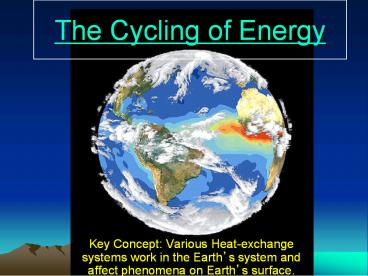The Cycling of Energy - PowerPoint PPT Presentation
1 / 20
Title:
The Cycling of Energy
Description:
The Cycling of Energy Key Concept: Various Heat-exchange systems work in the Earth s system and affect phenomena on Earth s surface. What You Will Learn Heat flow ... – PowerPoint PPT presentation
Number of Views:188
Avg rating:3.0/5.0
Title: The Cycling of Energy
1
The Cycling of Energy
- Key Concept Various Heat-exchange systems work
in the Earths system and affect phenomena on
Earths surface.
2
What You Will Learn
- Heat flow is the transfer of energy from a warmer
object to a cooler object. - Energy from the sun, the major source of energy
for phenomena on Earths surface, is transmitted
to Earth by radiation. - Heat from Earths interior reaches the surface
mostly by convection.
3
The Flow of Energy
- Energy can be carried from one place to another
by heat flow, waves, or by moving objects. - Heat flow is the transfer of energy from a warmer
object to a cooler object. - Wavessuch as water wave, light waves, and sound
wavestransfer energy through vibrations.
4
- Waves move energy, but they do not move matter.
- Objects carry energy while they are moving.
- As they move, the objects pass energy to objects
that they touch.
5
- The sun is the major source of energy for the
Earth system. - Heat from Earths interior supplies a much
smaller amount of energy. - Energy moves through the processes of radiation,
convection, and conduction.
6
Radiation
- All energy from the sun travels to Earth in waves
called electromagnetic radiation. - Electromagnetic radiation contains a wide range
of wavelengths, collectively referred to as the
electromagnetic spectrum. - Radio waves have the longest wavelengths, gamma
rays have the shortest wavelengths.
7
- All energy that Earth receives from the sun
travels through space as electromagnetic
radiation. - Wavelengths in or close to the visible light
range make up most of the energy given off by the
sun. - Some of this energy can pass through Earths
atmosphere and reach Earths surface.
8
- Energy from the sun drives the water cycle and
makes life possible on Earth. - Energy from the sun is absorbed by Earths
systems. - This energy is then converted to thermal energy
and transferred by convection and conduction.
9
Convection
- Most energy is moved through Earths systems by
convection. - Most convection occurs in fluids, such as water
and air. - Some convection can occur in solids that flow
like putty.
10
- The uneven heating of matter drives convection.
- Matter that is heated becomes less dense and
rises. Cooler, denser matter sinks. - The movement of matter that results from
difference in density is called a convection
current.
11
- In the ocean, differences in temperature and
salinity cause differences in density. - Salinity is the amount of salt in salt water.
- Cold, salty water has a higher density than warm,
less-salty water.
12
- In the ocean, convection causes deep currents.
- Deep currents are stream like movements of water
far below the ocean surface. - Deep currents take more than a thousand years to
travel around the entire ocean.
13
- Convection currents in the atmosphere form when
cold air sinks and forces warm air away from
Earths surface.
14
Convection in the Geosphere
- Convection also occurs in the geosphere.
- Energy produced deep inside Earth heats rock in
the mantle. - The heated rock is under high pressure, so it
becomes plastic without melting.
15
- The heated rock flows like putty.
- As it becomes less dense, the heated rock rises
toward Earths surface. - The cooler, denser rock surrounding the heated
rock sinks.
16
- In this way, heat inside Earth moves toward the
cooler crust. - This movement of rock is a convection current.
- Convection currents in the mantle cause the
movement of tectonic plates.
17
Conduction
- When objects at different temperatures touch,
their particles interact with each other. - Fast-moving particles in the warmer object
transfer energy to slower moving particles in the
cooler substance. - This causes the particles in the cooler substance
to move faster and get warmer.
18
- Energy can be transferred between the geosphere
and the atmosphere by conduction. - When Earths surface is warmer than the
atmosphere, the ground will transfer energy to
the atmosphere. - When air comes into direct contact with the
Earth, that energy is transferred by conduction.
19
Earths Energy Budget
- Energy on Earth moves through and between four
spheres. - These four spheres are open systems, which means
they constantly exchange energy with each other. - Energy is neither created nor destroyed.
20
- It is simply transferred between spheres and
converted into another form of energy. - You can think of this movement of energy as part
of an energy budget. - An addition of energy in one sphere means a
subtraction of energy in another.

